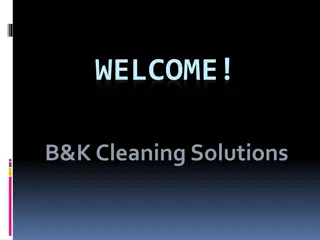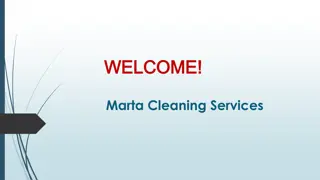Enhanced Cleaning Protocols for Classrooms and Common Areas
Spread through respiratory droplets, COVID-19 requires rigorous cleaning protocols in class and common areas. Key measures include mandatory mask-wearing, hand sanitizing, physical distancing, and regular surface cleaning using alcohol wipes and disinfectants. Classroom staff play a crucial role in maintaining high-touch surfaces virus-free, protecting both students and custodial staff. By following these detailed protocols, a safe environment is ensured for teaching and learning.
Download Presentation

Please find below an Image/Link to download the presentation.
The content on the website is provided AS IS for your information and personal use only. It may not be sold, licensed, or shared on other websites without obtaining consent from the author. Download presentation by click this link. If you encounter any issues during the download, it is possible that the publisher has removed the file from their server.
E N D
Presentation Transcript
CLASS ROOM/COMMON AREA CLEANING PROTOCOLS It is spread from person to person mainly through respiratory droplets from someone who is infected. Department of Facilities Management COVID-Operations Plan For Class Room/Common Area Cleaning Admin/Custodial/Teacher Guidance It can spread to others from coughing, sneezing, singing and even talking. It also can spread from contact with contaminated surfaces or objects.
CLASS ROOM PROTOCOLS Staff and Students all wearing masks correctly. Hand Sanitizing Supplies have been provided to all class rooms Staff/Students hand hygiene in and out of class. Physical distancing as much as possible with class room furniture rearranged to maximize distance between students. Students all facing same direction or rearranged in groups that provide the best social distancing measures. Alcohol Wipes with a 75% Alcohol Content have been provided to every class room. The wipes should be used to wipe down tables and student items like chrome books just prior to leaving class. Cleaning of toys with wipes or soap and water left to dry over night. Teachers and Students can perform surface sanitation near the end of class as students are ready to move onto the next class. Student assistance as age appropriate.
CLASS ROOM PROTOCOLS CONTINUED Teachers should sanitize with the alcohol wipes high point touch areas in their room as time allows between classes or in the case of cohort classes as appropriate for these areas of frequency of being touched. A bottle E22 of Diluted Eco One Step Disinfectant- Deodorizer-Cleaner has been provided to each class room. This cleaner is not food safe and should not be used on items such as toys or items that students would place in their mouths in the case of younger students-K4-K5 The E22 has a surface dwell time of 10 Minutes and is only for use after the end of all classes for the day. Teaching Staff should then use this spray to spray tables- chairs-high touch areas in their room then leave for the day. The mist will dry and kill all viruses that maybe present in about a 15 minute average time span. The use of the E22 at the end of the day is one of the most critical sanitation steps prior to 2nd shift custodial staff entering your room for the night time cleaning. Touchpoints
CLASS ROOM PROTOCOLS CONTINUED The use of the E22 by the teacher at the end of the day provides a virus free class room which protects the custodial staff when entering to perform routine and high touch night time cleaning. The teacher is providing the first high touch sanitation in this process. Touchpoints This is followed by the custodial staff performing routine cleaning and a second high touch point cleaning that also removes the left over residue of the E22 that was applied by the teacher at the end of their day. This provides a double high touch cleaning to insure a virus free class room for the next teaching day. The SDS sheet will be sent along for the E22 as required. The E22 is in a diluted form and does not require the full PPE in this form other then the mask you are already wearing for COVID.
COMMON AREA CLEANING PROTOCOLS Common area nightly cleaning will be done after all class room common cleaning and high touch points have been completed. Public Areas / Reception / Lobbies The last custodial duty of the day will be to spray all common areas entrances/corridors/cubbies with a power sprayer of San-Q a general purpose disinfectant. This product is applied and left to dry in place. This product was specifically designed for this purpose. The spray is designed to spray the proper amount of particulate of the product to cover complete surfaces and kill viruses. Restrooms The use and proper application of these protocols ensures the new school day will start with all surfaces being properly sanitized for the reentry of teachers and students when entering common areas and class rooms. Lift / Stairs / Elevator Then the process repeats and becomes a redundant mitigation measure ensuring that the environment has a virus free touch zone.























